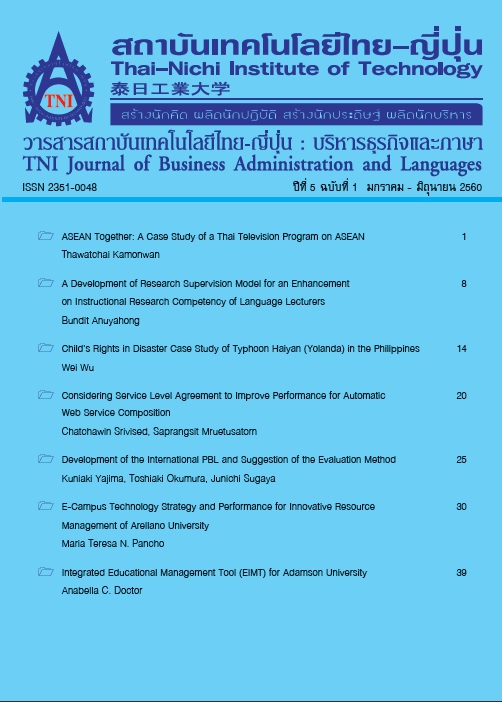ASEAN Together: A Case Study of a Thai Television Program on ASEAN
Main Article Content
Abstract
Where is the knowledge about ASEAN member countries from? Thai people can not learn about ASEAN member countries by direct experience, but they can learn and enjoy through mass media like window to ASEAN neighbors. TV programs concerning ASEAN is an interesting case study. The TV programs on ASEAN present various aspects, such as social, cultural, religious, historical, economic, political, and leisurely facets of ASEAN member countries that are ASEAN daily lives. In Thailand, ASEAN Together is one game show TV program for youth mainly concerning about ASEAN and ASEAN member countries. The images represented ASEAN member countries in the media is important for Thai people’s perception on international relation, and Thai people’s attitude toward other countries in ASEAN. Also, this research analyses and focuses the proportion and reproduction the content about ASEAN member countries, and the representation of ASEAN member countries embedded in the content of ASEAN together.
Article Details
Article Accepting Policy
The editorial board of Thai-Nichi Institute of Technology is pleased to receive articles from lecturers and experts in the fields of business administration, languages, engineering and technology written in Thai or English. The academic work submitted for publication must not be published in any other publication before and must not be under consideration of other journal submissions. Therefore, those interested in participating in the dissemination of work and knowledge can submit their article to the editorial board for further submission to the screening committee to consider publishing in the journal. The articles that can be published include solely research articles. Interested persons can prepare their articles by reviewing recommendations for article authors.
Copyright infringement is solely the responsibility of the author(s) of the article. Articles that have been published must be screened and reviewed for quality from qualified experts approved by the editorial board.
The text that appears within each article published in this research journal is a personal opinion of each author, nothing related to Thai-Nichi Institute of Technology, and other faculty members in the institution in any way. Responsibilities and accuracy for the content of each article are owned by each author. If there is any mistake, each author will be responsible for his/her own article(s).
The editorial board reserves the right not to bring any content, views or comments of articles in the Journal of Thai-Nichi Institute of Technology to publish before receiving permission from the authorized author(s) in writing. The published work is the copyright of the Journal of Thai-Nichi Institute of Technology.
References
K. Kanjana, Mass communication Theory and concept,. Bangkok: Parbpim, 1998.
L. Komjorn, Southeast Asia film: film studies and cultural studies, Bangkok: Thammasat University, 2004.
Nothareeh Heamthanon, “Analysis on formats and contents of television program on ASEAN between Thailand and Indonesia” Unpublished doctor’s thesis, Thammasat University, 2013.
D. Natthakrit, Representation of marginal teacher in the TV dramatized documentary “Khon Khon Khon.” Bangkok, Thailand: College of Social Communication Innovation Srinakharinwirot University, 2014.
H. Stuart, Ed., Representation: Cultural Representations and Signifying Practices, 1st ed. London ; Thousand Oaks, Calif: SAGE, 1997.
K. Kanjana, Mass communication Theory and concept,. Bangkok: Parbpim, 1998.
N. Nattika, “News about neighboring countries in ASEAN published in three Thai daily newspapers,” Master’s thesis, Thammasat University, 2005.
Theedet Chaiha. (2009). Representation of Burmese in Thai films. [Online]. Available: https://library.cmu.ac.th/rsc/?newsdetail. php&id=320
H. Nothareeh Heamthanon, “ASEAN television program of Indonesia: Case Study of “ASEAN Today”of the Metro TV station,” Doctor’s thesis, Thammasat University, 2014.
Nongnuch Limtrakul, & Kittima Chanvichai. (2014). The role of presenting ASEAN news: case study of ASEAN journey. [Online] .Available:https://www.bec.nu.ac.th/becweb/graduate/Article%5C2556%5Ccommunication/%E0%B8%99%E0%B9%89%E0%B8%AD%E0%B8%87%E0%B8%99%E0%
Thompson, Eric and Chulanee Thianthai. (2007). Attitudes and awareness toward ASEAN: findings of a ten nation survey [Online]. Available: https://www.aseanfoundation.org/documents/ Attitudes%20and%20Awareness%20Toward%20ASEAN.pdf
Nongnuch Limtrakul, & Kittima Chanvichai. (2014). The role of presenting ASEAN news: case study of ASEAN journey. [Online]. Available:https://www.bec.nu.ac.th/becweb/graduate/Article%5C2556%5Ccommunication/%E0%B8%99%E0%B9%89%E0%B8%AD%E0%B8%87%E0%B8%99%E0%
C. Pornchai, A presentation of cultural contents about ASEAN Community in Thai TV documentary programs. n.p., 2557.
S. Dhanakorn , “Thailand and agenda setting of ASEAN community ,” Doctor’s thesis, Thammasat University, 2013.
L. Komjorn, Southeast Asia film: film studies and cultural studies, Bangkok: Thammasat University, 2004.
H. Stuart, “Encoding, Decoding,” in The Cultural Studies Reader, 3rd ed., n.p.: Routledge, 2007, p. 576.

